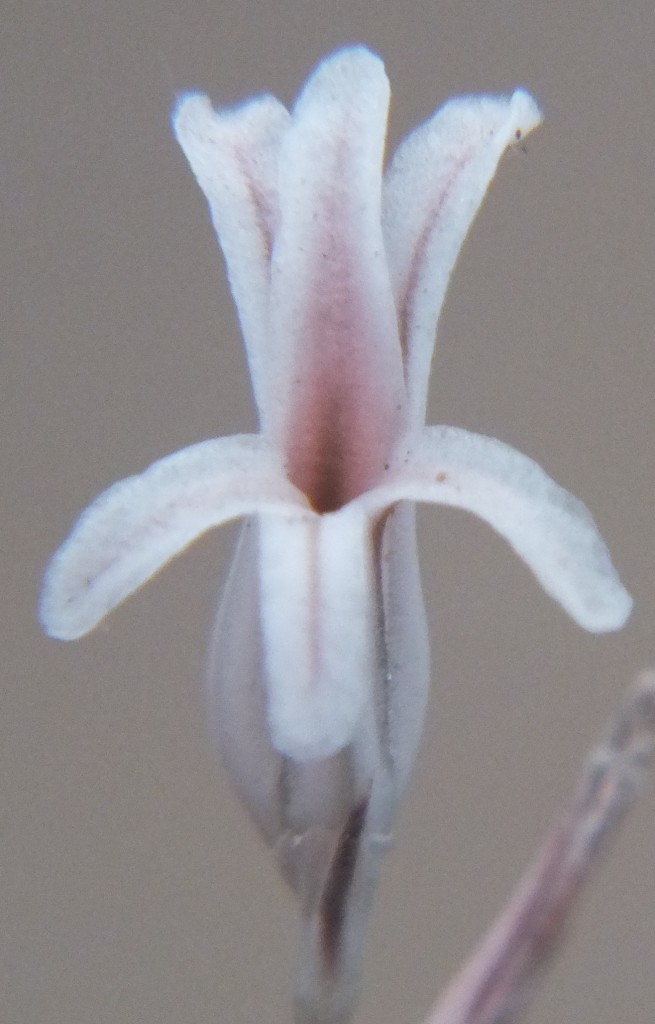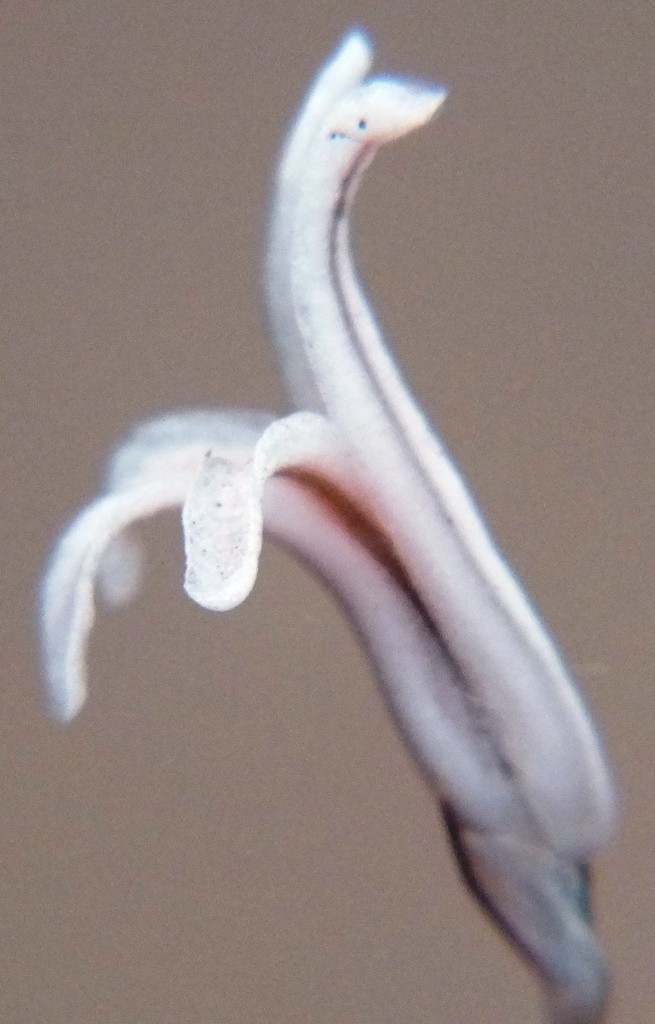In 1943 Dr. J. Luckhoff, who was better known as a collector of stapeliads, wrote up some observational and collecting records of Mr. M. Otzen after whom Haworthia otzenii was named. Most of these records have been followed up at one time or another and we know what most of the plants and populations were that he recorded. However, there is one particular item that remains a mystery. One of Otzen’s records reads like this:
”About six miles north of the six or seven houses forming Infanta there is a large salt-pan on your right … Four miles further south follow a narrow track on your right, which ends on a bluff on the foreland called Cape Infanta. On the southern slope towards the sea a very small Haworthia, almost black, with longer, narrower leaves than H. retusa, very scarce, and very difficult to find.”
Otzen does say for another record north of Bredasdorp that the small black species growing there is “similar to the Cape Infanta one”. This Bredadorp record is referable to H. maraisii, and I infer that the plant at Cape Infanta must be this species too. Nevertheless this small black plant at Infanta has bothered me for years. I did look for it in 1972 on the only excursion I ever undertook to this fairly remote area, but I mis-read the Otzen note and searched in vain on the rocks south of Infanta. While writing a review of my collections, a plant Adam Harrower of Kirstenbosch had given me started to create some problems. It did not fit the pattern of “flow” that I had so far observed for haworthias. Harrower’s record was for the Potberg Mountain where I had already obtained plants that were odd in one way or another. When I finally asked Adam for the detail of his collection, it appeared that he had collected it only about 10km from Cape Infanta. The plant is similar to that of one collected by the late C. Burgers of the Cape Department of Nature Conservation, at Buffelsfontein 20km further west. Both of these localities are on the south side of the Potberg, the vegetation is fynbos and the geology is Table Mountain Sandstone. My assessment of the two collections was that they were somewhat similar to H. mirabilis var sublineata. This is not a comfortable conclusion because of the geographical intercession of H. rossouwii var petrophila just west of Bredasdorp, and of H. rossouwii var calcarea from near the DeHoop residential complex. There are also five other populations recorded from the northwest corner of the Potberg but which have only an indirect relevance to the thrust of this article, so I exclude them. In fact I also exclude them from a magnum opus that I am preparing because the problem is so extensive and complex.
The question of the identity of H. maraisii is something that I am trying to answer in a separate rather long manuscript. There I will discuss a whole suite of species and the end product will probably be too long for journal editors or readers. The crux of that presentation will be that species names do not actually convey the information that we expect them to, and that collectors are caught up in a confusion of names that have commercial, egocentric and any other meaning but that within the orderly one of an informative botanical science that we unthinkingly expect
What I am considering and trying to explain in that big work in preparation, is that there is no distinction that one can actually make between all the variants of H. mirabilis and of H. maraisii (and more) that I recognize in my revision. Down at Infanta H. maraisii tails away to a tiny dark plant through a series of populations that probably confound any perception that only one species is involved. The problem is compounded by the fact that juxtaposed on either side of the Potberg Mountain are two plant populations. One could be H. mirabilis, the other H. maraisii. This confounds my argument because in the context of my longer manuscript I show that these are one and the same.
Thus Otzen’s record takes on a slightly larger dimension and I wanted to explore further south and east of the juxtaposed populations to see if any connection could be found. This found my wife and me at Infanta where J.D. (Kobus) Venter later joined us. We did find new populations. In the one collection the plants are small and dark with very erect leaves and similar to those cited in my Revision (1999) under the name H. maraisii var. maraisii (in which the leaves are classically retuse, ‘bent-back like a thumb” to use an apparently obsolete meaning – but see figures). The collection cited in my Revision is one by P.V. Bruyns from the east bank of the Breede River opposite the farm Ziekenhuis (Fig.1 JDV87-50. Kobus Venter found the same thing on the west bank at Jakobsrivier (Figs.2a & b JDV92-85). My new collection (MBB7250) is similar and about 1km east of that. The geology at this locality is rather hard to fathom and seems to be recent (quarternary) riverine or marine deposit overlying Ecca shale. The vegetation is also rather anomalous and would probably fall under Renosterveld. It is the second (MBB7248) and third populations (MBB7249) that stunned us, because the plants revert to being larger in size, with fully retuse leaves having an end-area level to the ground. Furthermore the end-surfaces are spinose (Figs.3 MBB7248). Such spinescence occurs in H. emelyae var. major and also in a population of H. magnifica just east of Riversdale. It does, however, also occur to a lesser degree at both population- and single-plant-level in many other populations. As an aside, it is actually possible to suggest that here we have the convergent emergence of a species character independently in another distant population. The geology at these last two sites is sandstone and the vegetation Fynbos.
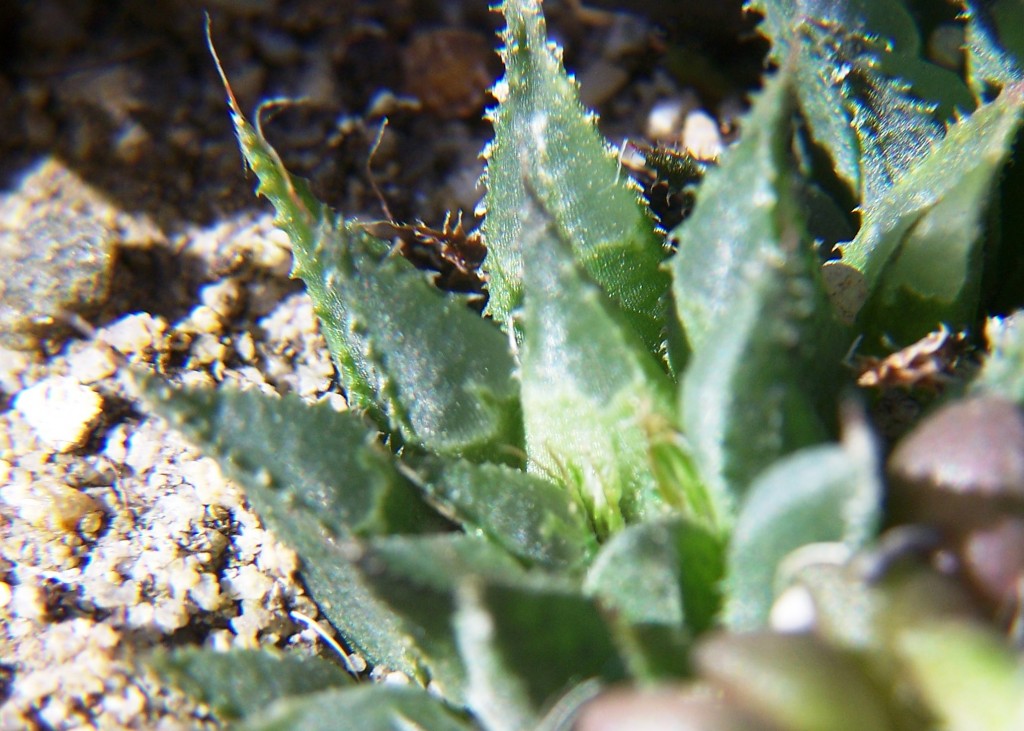
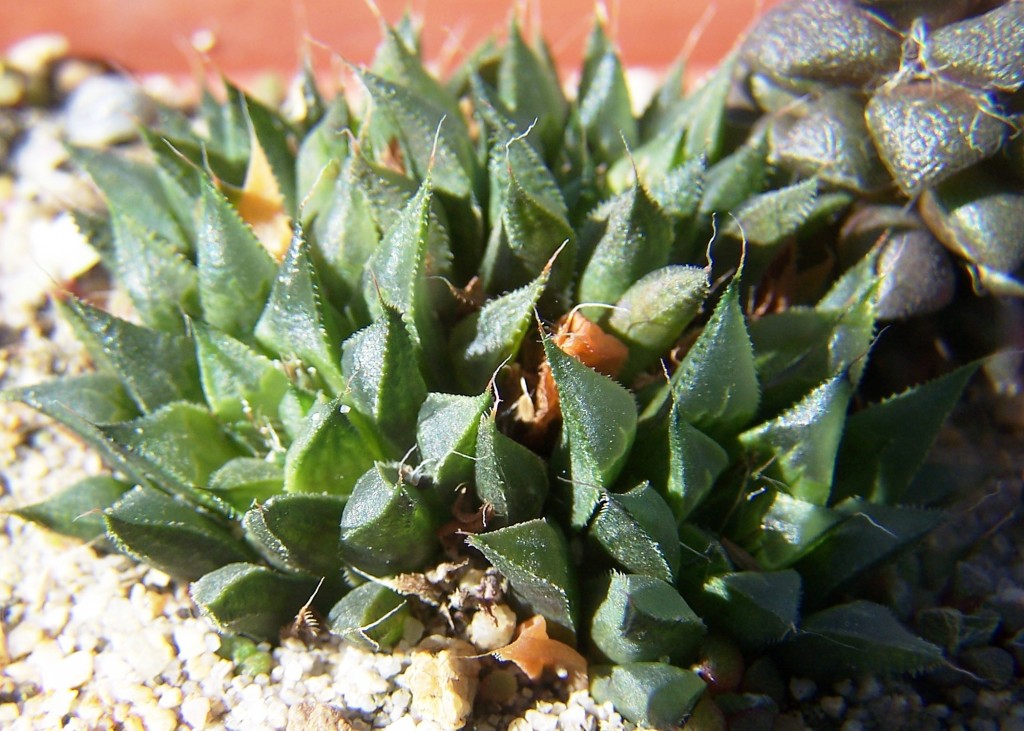
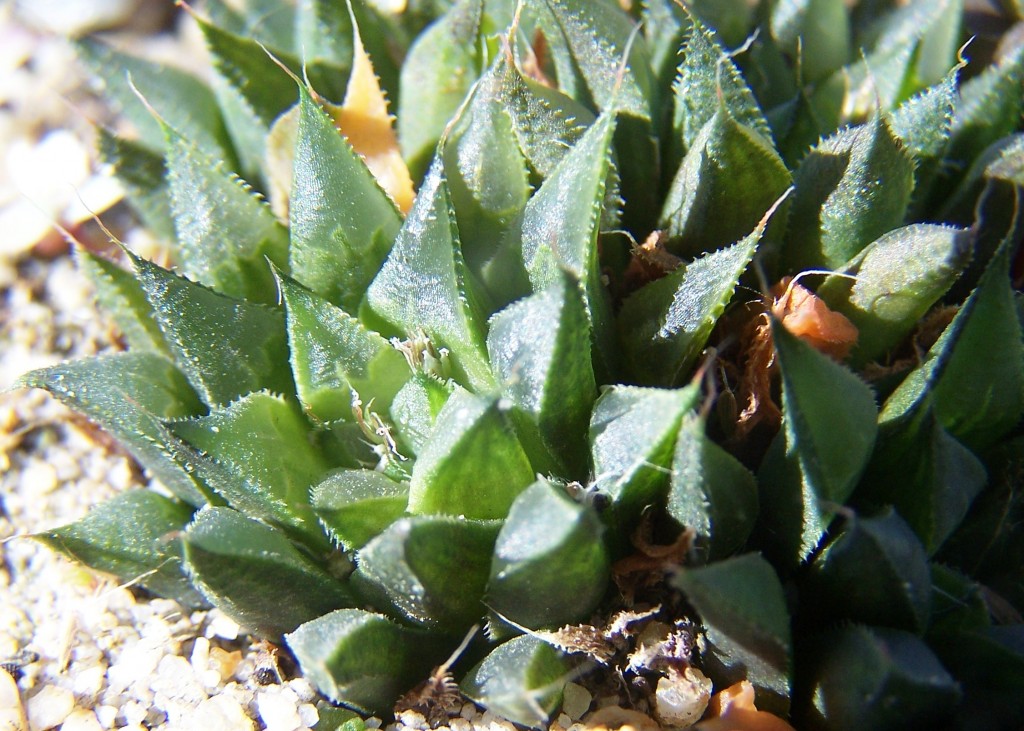
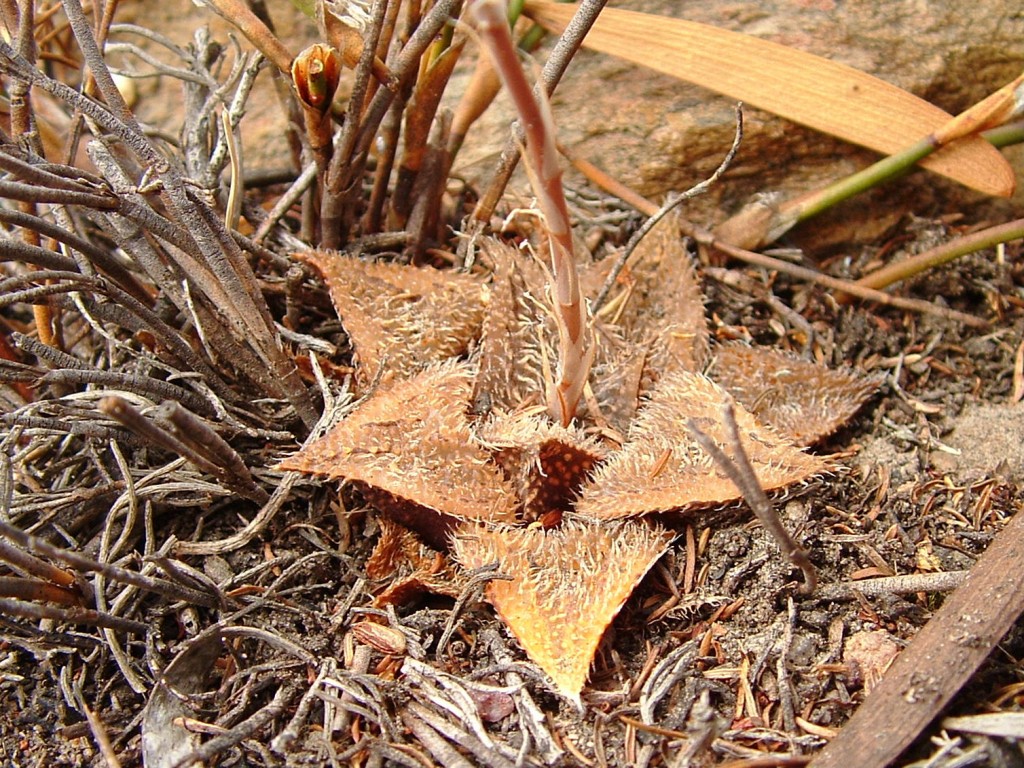
When Kobus joined us the following day, Keith Spencer and his staff of the De Hoop Nature Reserve accompanied us to Cape Infanta. Keith was naturally interested to know what we were looking for as well as serving the supervisory role for the Reserve. Cape Infanta is a windy bluff along a rocky shore where the rocks rise almost directly from the sea to a height of about 30m. The geology is quite complex and is mapped as calcarenite commonly called Cape Limestone. The vegetation was very typically Fynbos although there were many mesems too. We did not find any haworthias after quite a thorough search and we gave up the attempt deciding rather to trace Adam Harrower’s record. We did this without too much difficulty though we wondered why Adam should have thought the locality (near Sandhoogte) was promising for any odd things he was looking for in his search for herbaceous plants for horticultural screening. The locality is a rocky (sandstone) ravine bank with Fynbos vegetation. Adam’s plants were quite common but not all that easy to find. Although I make the connection to H. mirabilis, I also feel that there is some justification for calling in H. rossouwii var. calcarea for comparison (Fig.4a ADH594, & b MBB7251). One of Keith’s rangers then maintained that he had in fact seen a similar plant at Cape Infanta and so we retraced our steps. We searched in a different direction but still failed. Reading Otzen’s notes, one is filled with a sense of depression because it is apparent that the collection may have had commercial undertones. It is known that Triebner was purchasing plants from collectors and Otzen’s one record reads…”Doubt whether there are any left after Venter, Werth, Geyer, Malherbe and I have been there.” Another reads, “three of us searching for more than an hour, found only three specimens – doubt that there are any more.”

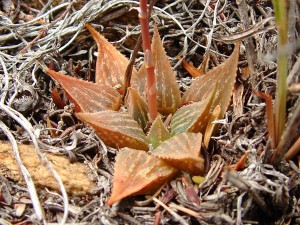
The one common binding factor in these populations we saw is the fact that they were in flower and beginning to fruit. The southwestern Cape haworthias seem to fall into two groups on the basis of flowering time viz. a spring-flowering time, and a late summer- flowering time. I wrote an article for Aloe (40:10, 2003) in which I discussed ecotypes of haworthias on the Zuurberg Mountains. I have to conclude that this is probably what we are seeing here, coupled perhaps with a dispersal history that has carried plants (genetic material) from the south and west, and independently from the north and east. However, it is more complicated than that. The resemblance of the Harrower collection to H. turgida var. longibracteata is noteworthy. Harrower’s population juxtaposes our spinescent find and only 3km separates them as the crow flies. Burger’s collection at Buffelsfontein is juxtaposed by only 5km with H. turgida var. longibracteata at Diepkloof. We should have gone on to examine the Buffelsfontein population as my confidence in declaring it to be the same as that at Sandhoogte was only based on a herbarium specimen. Co-incidentally, there is also a specimen collected by Prof. Compton that has a close likeness to the Buffelsfontein plant. Compton’s record is remarkable for the statement that it was collected on “the Potberg sandy flats”. There is so much “sandy flat” surrounding the Potberg, that the re-discovery of this population will be purely fortuitous. We did in fact get a later opportunity to explore Buffelsfontein and find Burger’s population (Fig.5 a & b MBB7374) and my conclusion is that it is a continuity of MBB7248 and ADH594. In the light of Chapter 15, I can hazard a guess as to how this really fits in.
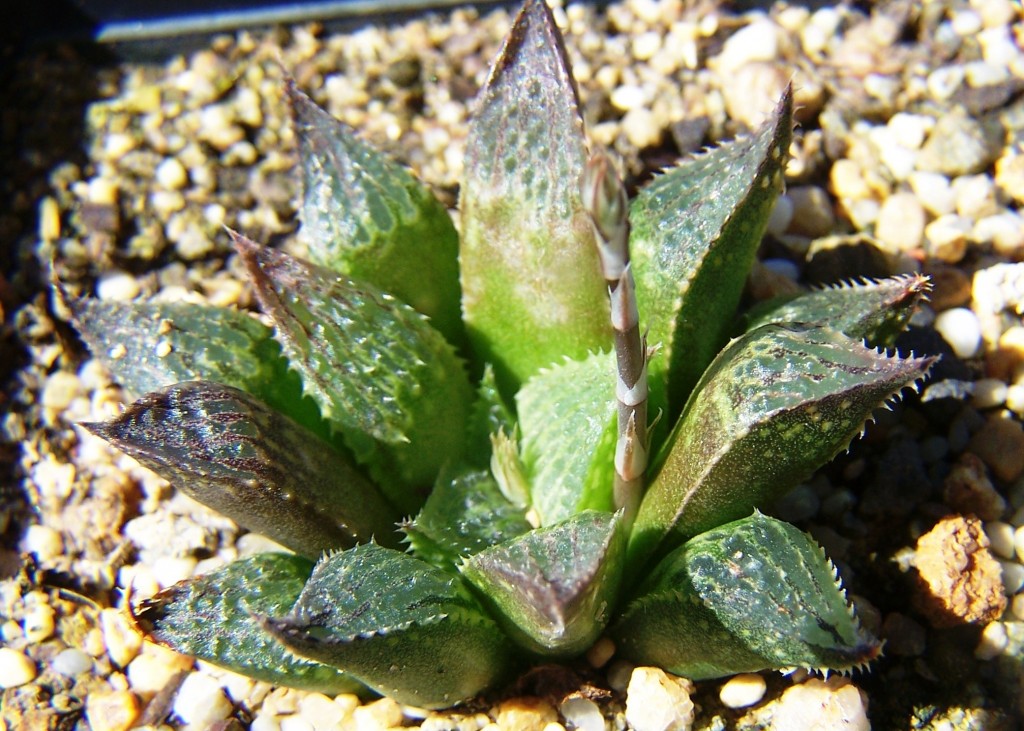
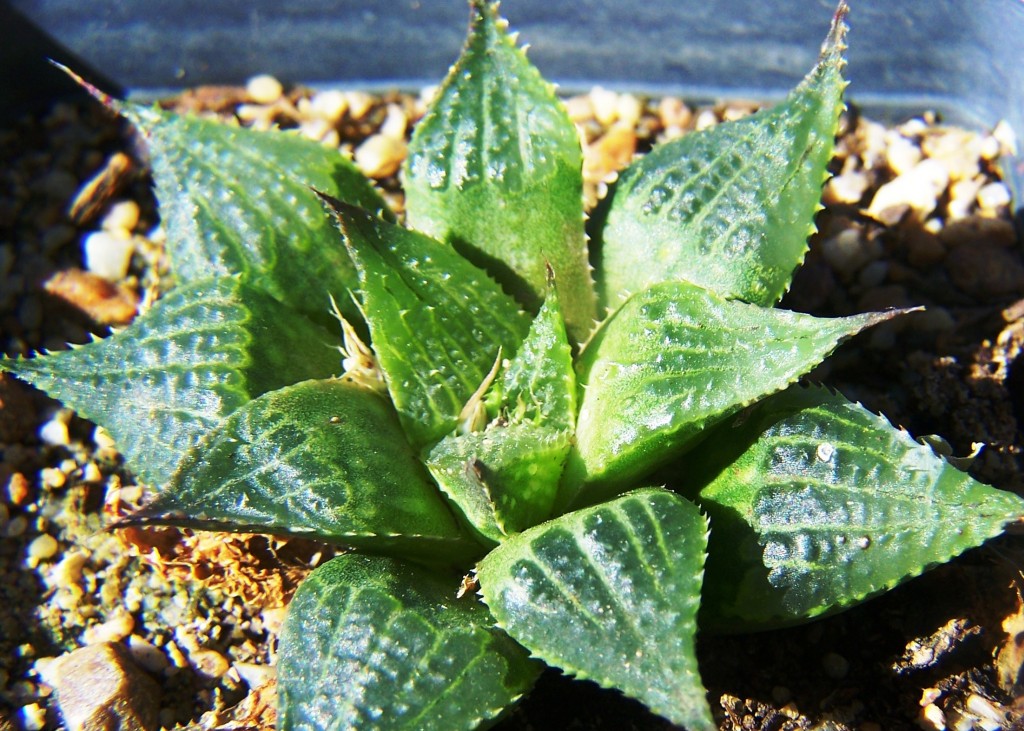
Our excursion did not therefore resolve any problems and instead seems to have added to the complexity of the situation. I have been writing for a long time about haworthias and have been finding it increasingly difficult to precisely and concisely explain the ramifications of all these new things that keep turning up. I have never thought that simply generating new names is going to add anything to our knowledge of the plants as a group. My feeling is that a good classification should communicate something about the plants. It is therefore exceedingly disheartening to read a quotation from the book by D.A. Levin The Origin, Expansion and Demise of Plant Species (Oxord University Press, ca 2000). He quotes authors Raven, Berlin and Breedlove, who say… “our system of names appears to achieve a reality which it does not possess”. Levin himself writes…“our taxonomic system communicates little about the organism being considered, although it appears to communicate a great deal”.
Levin discusses the species concept at some length and I doubt if I could debate the subject at his academic level. My contention is that he makes much the same mistake as all these people who discuss the matter – they do not define the word “species”. Levin’s introductory chapter is a discussion of premise and concept and there are many sentences that can be taken to represent fragments of a definition, but he ends it by saying that “the choice of concept has to do, in part, with the perspective that gives one satisfaction”. I find this alarming because to my mind it leaves the definition open and subject to interpretation and whim. We will never have even crude agreement of a classification if each of us follows the matter to one’s own satisfaction. To some extent this objection is overcome by his closing statement that: “it is important to understand the biological properties and relationships of population systems rather than get hung up on putting them into conceptual pigeonholes”. My only response to this is that we should try to understand these properties and relationships in the process of conceptualizing such pigeonholes.
This brings me to a closing argument. In Avonia 21:45 (2003) Breuer describes six new species and six new varieties of Haworthia. Only one of them is meaningful to me; the others all fall into my existing conceptual pigeonholes derived from a definition of species that have genetic, morphological, geographic and behavioral similarities. My dissatisfaction is that the descriptions have as their one visible goal, the need to satisfy or nourish the acquisitive urge of collectors while neglecting – even negating – any obligation that these descriptions should possess or add meaning. This is the same argument I would put forward for any name changes. If they do not add or contribute meaning, they should not be made. Names should convey more than a collector’s item that is in essence only a source of income to a commercial outlet and an expense to a collector. Another goal may simply be the egocentric one that builds on this false notion of “meaning” and “discovery” associated with names, which of course could be satisfying to the author too (and of course the collector commemorated in the name).
What is the exception in those 12 new taxa of Breuer’s? It is H. elizeae said to be from west of Swellendam (Figs.6a, b, c, d, & e MBB7255). The plant was it seems first collected by Derek Tribble in 1977. According to Breuer it was apparently also collected by E. Esterhuizen and by V. deVries and the latter is credited in the citation of the type (deposited of all places, in Tokyo). It is quite strange that the plant is otherwise unknown except that so many places are unexplored in the sense that anyone can barely know what is new or common on any site. This particular site is within a stone’s throw of Stormsvlei that is a common collecting ground for Haworthia. On our way home from Infanta I thought I should try to examine the population. The resemblance I could see while looking for information and meaning in the description and illustration, is one to H. rossouwii (Fig.7) which species has a very odd broken distribution. There is also some resemblance in it to H. emelyae var. multifolia too. Breuer’s description in Avonia gives no meaning at all, other than to vaguely suggest a western extension of H. turgida and an equally vague comparison of the flower, viz. “the floral characteristics look a bit more like those of H. triebneriana than those of turgida”.
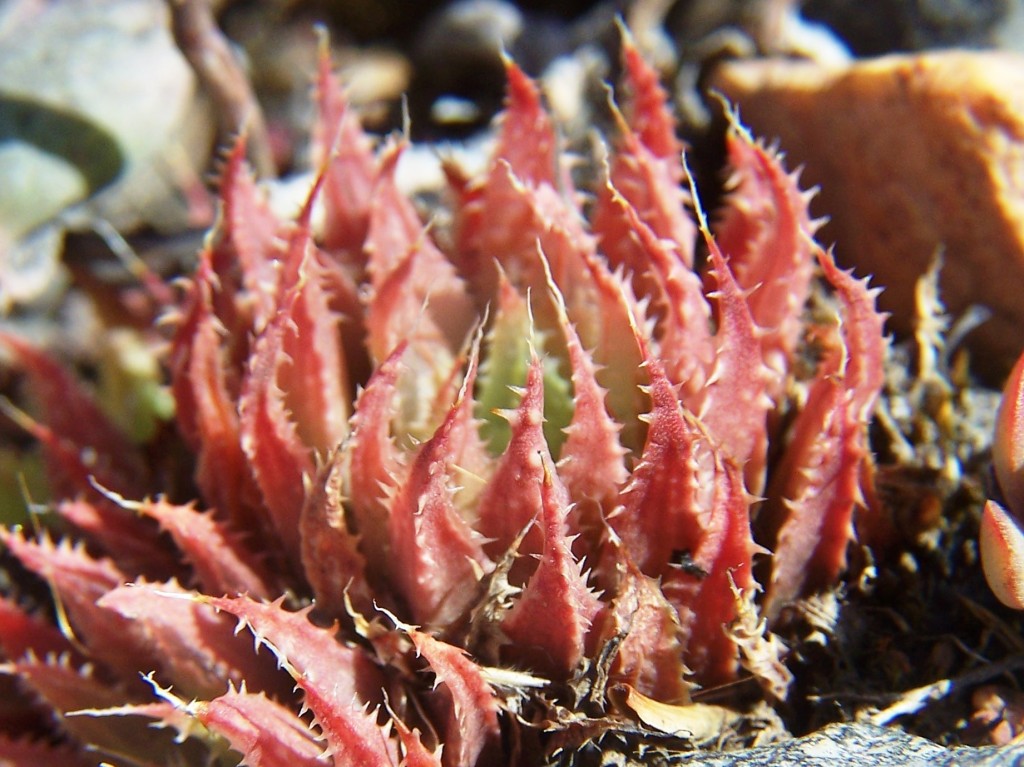
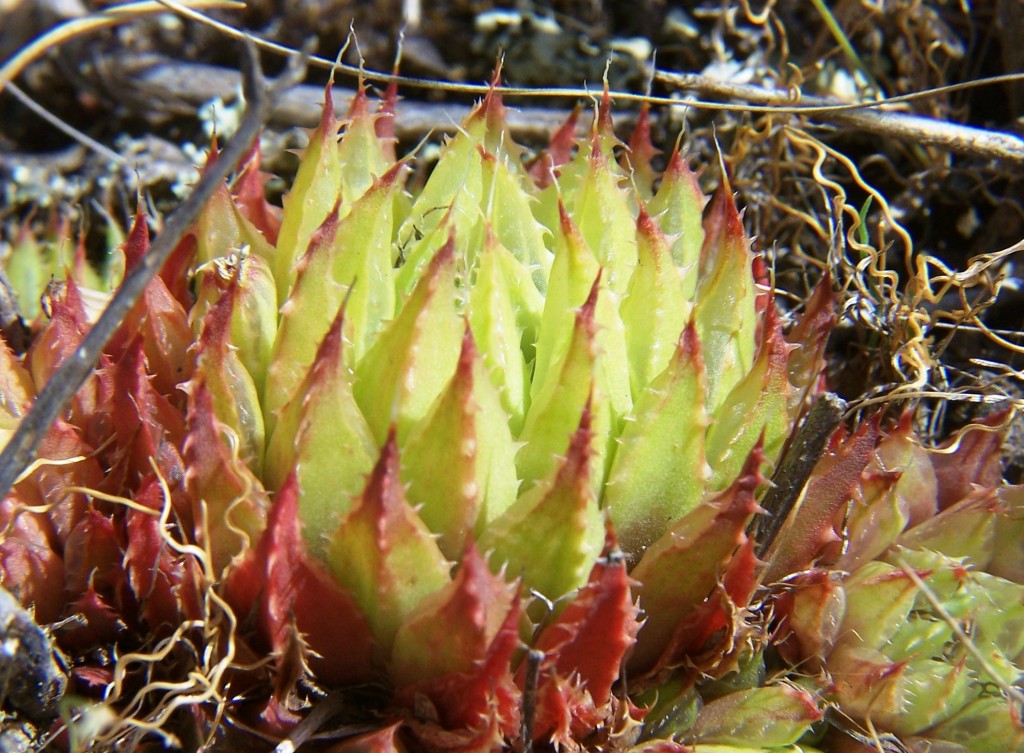
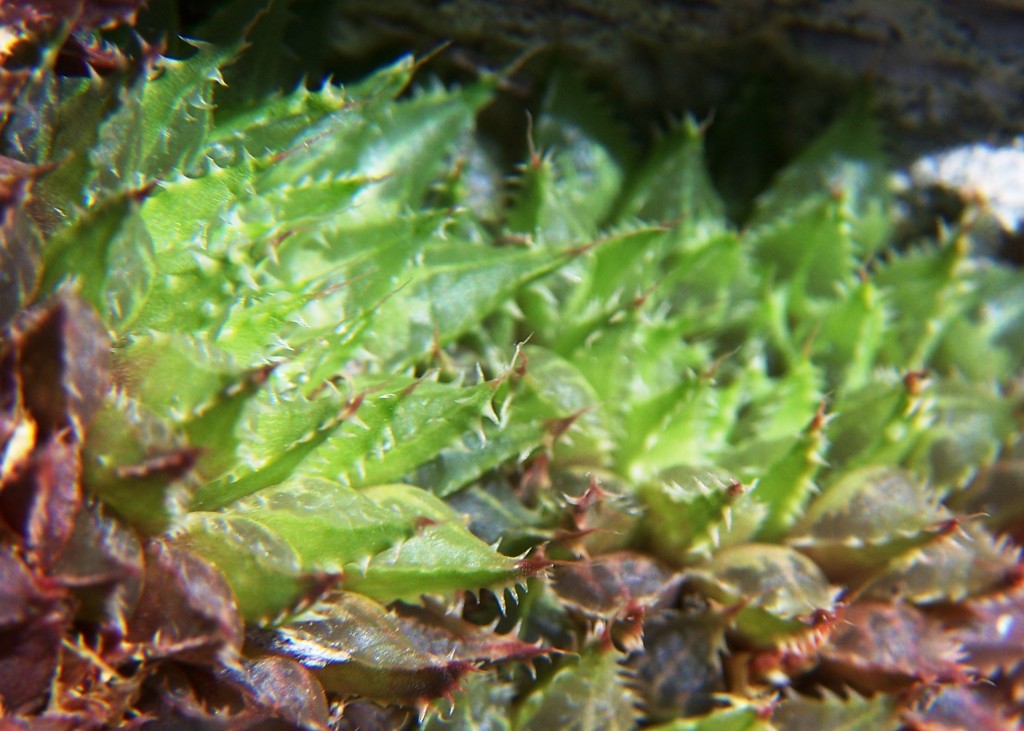
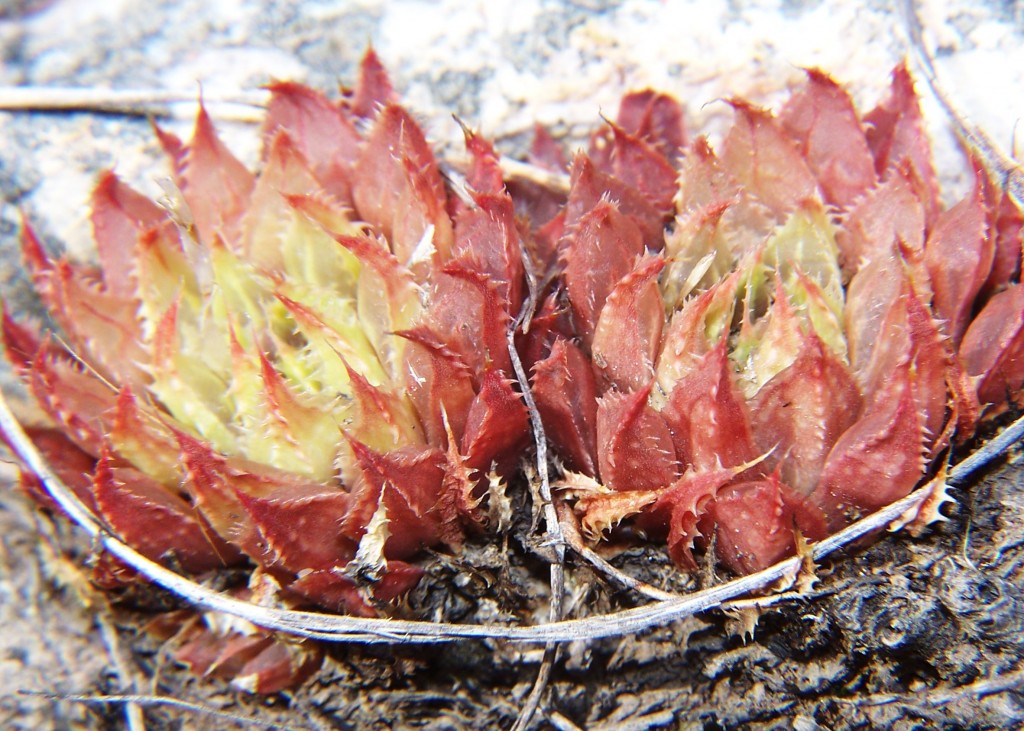
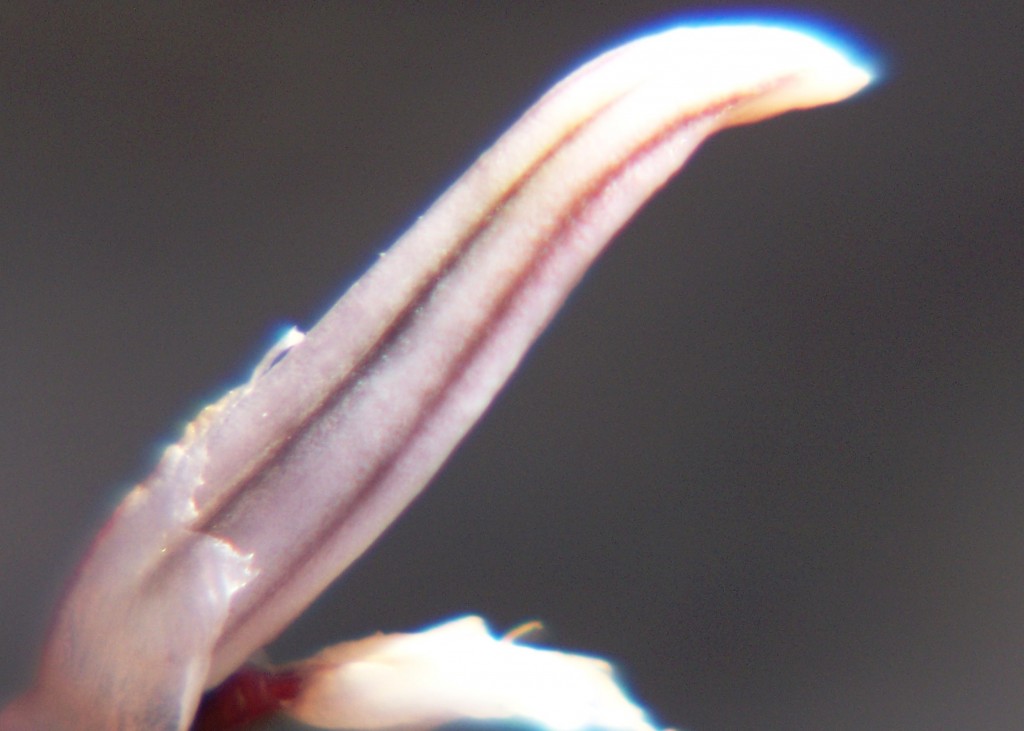
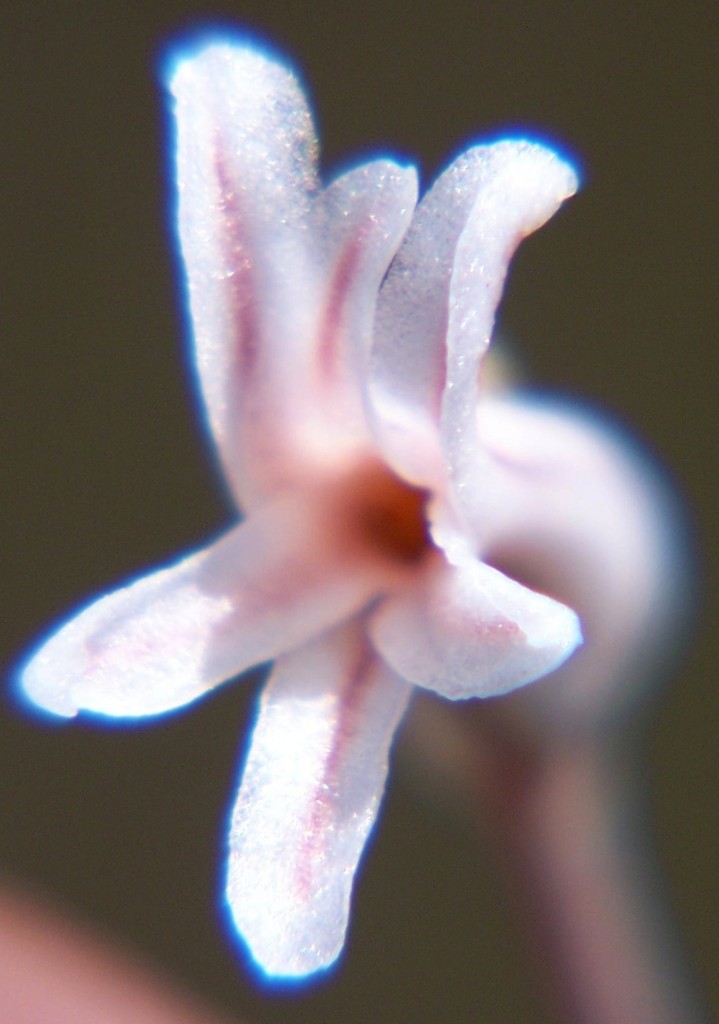
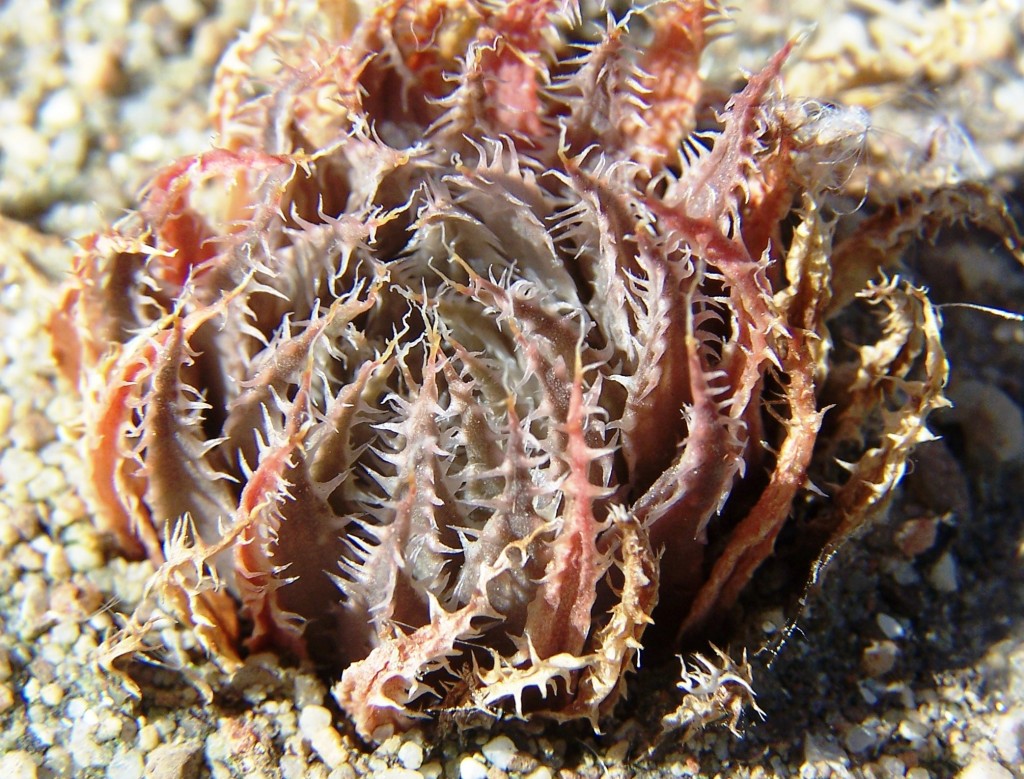
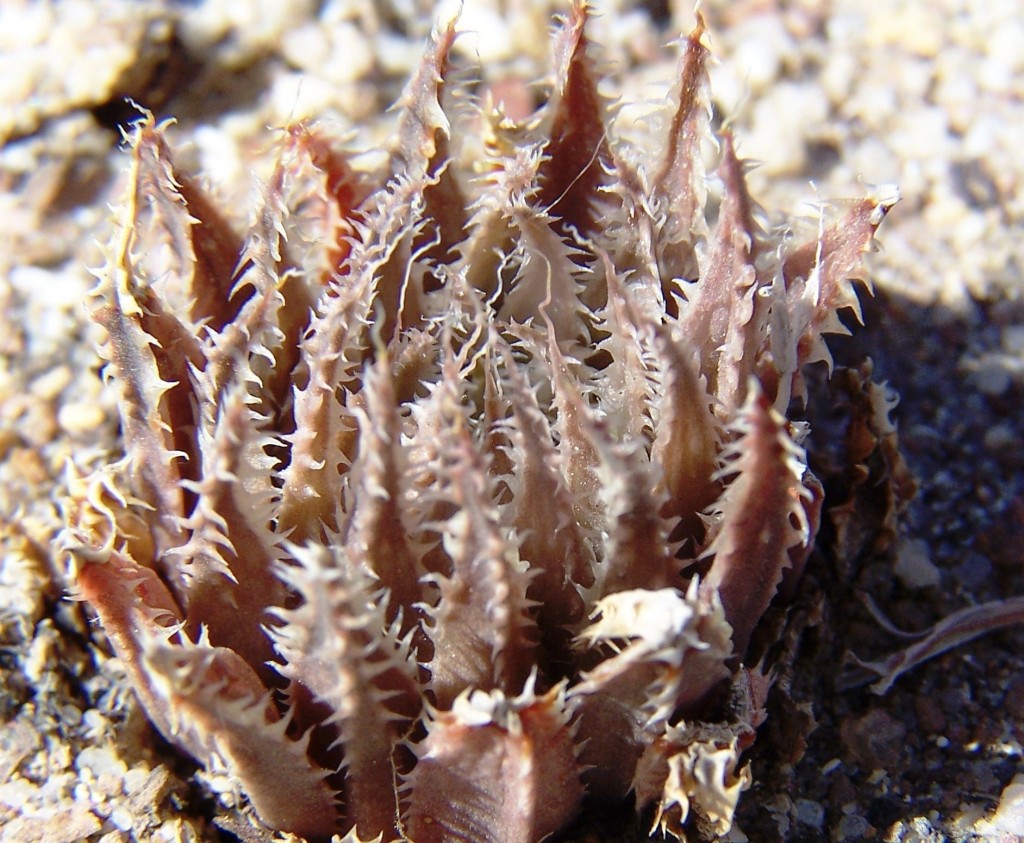
Given the locality as “25km west of Swellendam in stony outcrops”, we actually struggled to find the plants. Fortunately Derek Tribble provided a better description of the site. It is about 30km west of Swellendam and is not “stony outcrops”. It is a significant band of finely textured Table Mountain Sandstone abutted by Ecca shale. The population occupies a surprisingly small area comprising the rocky foreground in the two illustrations (Figs.8a & b). As the ridge continues east it rapidly becomes coarse-grained sandstone and is the home of H. mirabilis in the form that this species has in the nearby Stormsvlei Pass. (Using the name H. triebneriana for that population as Breuer apparently does, removes information from the system as will be evident when my review of that system is published.) H. elizeae is indeed different. It is a highly proliferous clustering plant and flowers in spring, or certainly earlier than H. mirabilis. It does not comfortably fit anywhere in my pigeonholes and I see the need to uphold the name in the way I uphold my own H. pubescens. I see the need to explore further, to see if the distribution can be extended in anyway. However, it seems very unlikely. I did not see any resemblance of the plants in the field to H. rossouwii as I had surmised from the illustration. But I do not think the possibility of a link to H. rossouwii should be totally excluded when anyone comes to trying to explain the question “how did it all happen?” Perhaps there is a closer resemblance to H. maraisii var. meiringii at Bonnievale where I drew a comparison with the spring-flowering H. herbacea. I also consider that H. maraisii var. notabilis (Fig.9 JDV98-1) at Robertson and Klaasvoogds could yield variants which parallel H. elizeae, and this is also possible true for H. mirabilis var. consanguinea from MacGregor. But these are all summer flowering.

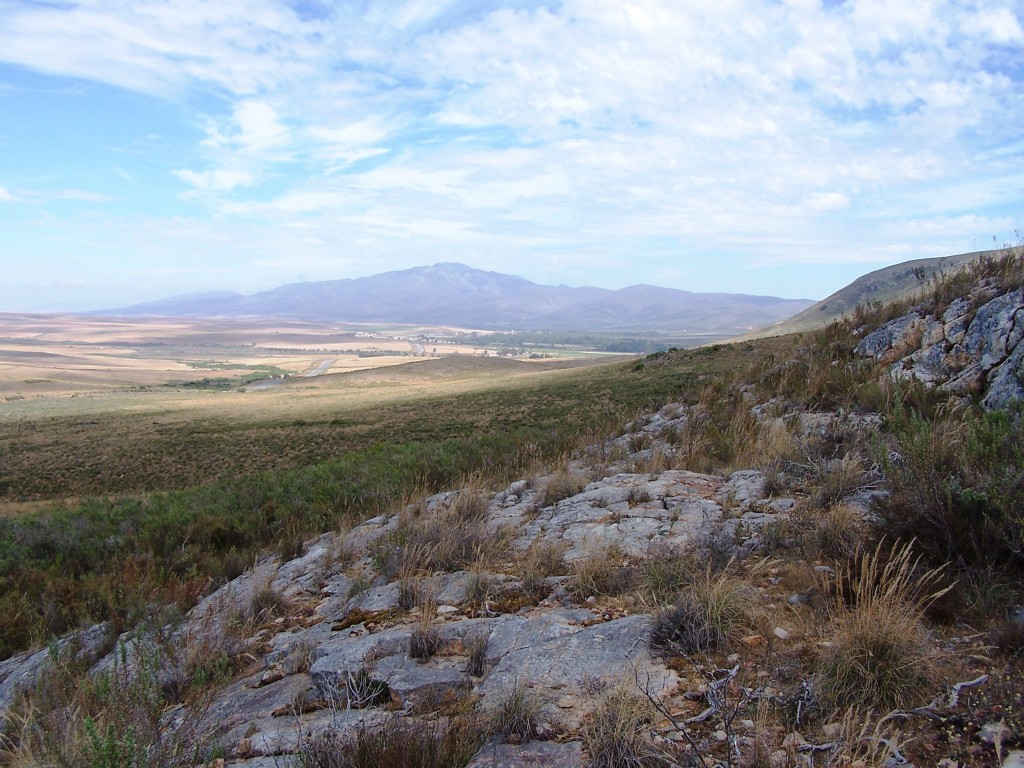
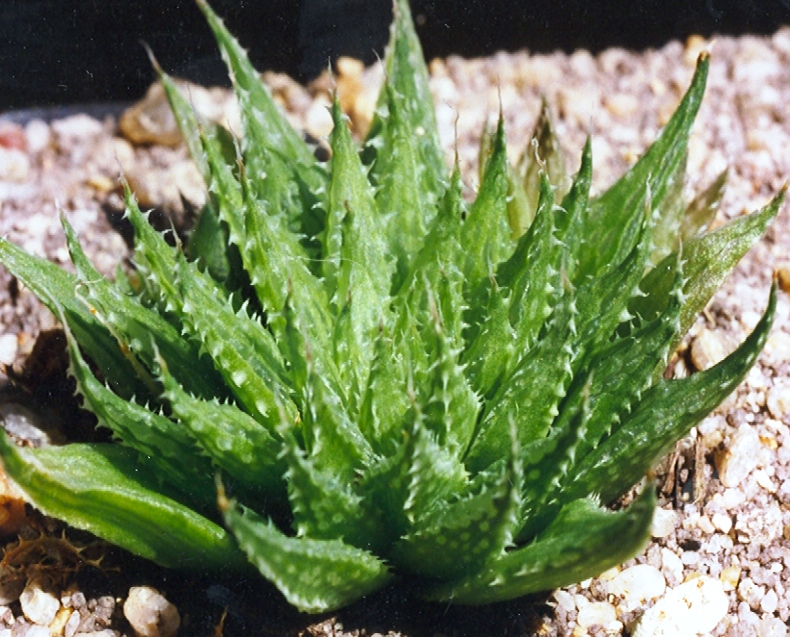
The message I would like to convey in this article is my belief classification must have meaning beyond that of items on a price-list or in fact on any list. My feeling is that botanical science has deluded and corrupted us all by the pursuit of classification as a cataloguing process instead of a methodology based on solid definition and purpose. Not in every instance, of course, and not to the extent that all taxonomists are culpable, but there certainly is an abuse of the system. This is perhaps what Levin refers to when he quotes Ehrlich and Raven who write of “a good species…an artifact of the procedures of taxonomy”. It is not surprising that many readers have become exasperated with taxonomists and “namenklutter”.
Acknowledgement
I state that my collecting was under accreditation of permit 45/2003 issued by the Western Cape Nature Conservation Board. I would also like to acknowledge the co-operation of Mr. Graham Lewis and Mr. Keith Spencer of De Hoop Nature Reserve for their assistance, Mr. Adam Harrower, Mr. John Douglas-Hamilton, Mrs. Christine Wallace and Mr. Hanrico Cilliers. Mr. Ingo Breuer kindly sent me a copy of Avonia 16. Messrs. Bob Kent, Steven Hammer, Elliot Adler and Paul Forster kindly commented on the text of my article where idiosyncrasies remain unfortunately my own.
Addendum
Flowers of MBB7255 H. rossouwii var. elizeae, Bromberg taken on 1 December 2012. ♦
